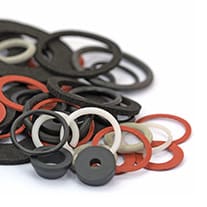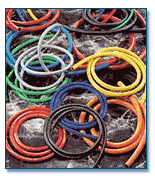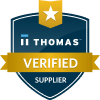What Are O-Rings?
 An O-ring is a donut-shaped elastomeric component that is used to create a seal at the interface of two or more joined parts in a system. Their simple yet effective design makes them an integral sealing solution in a wide range of applications, from sophisticated medical and electronic devices to safety-critical automotive and aerospace systems.To maximize their sealing
An O-ring is a donut-shaped elastomeric component that is used to create a seal at the interface of two or more joined parts in a system. Their simple yet effective design makes them an integral sealing solution in a wide range of applications, from sophisticated medical and electronic devices to safety-critical automotive and aerospace systems.To maximize their sealing
capabilities, O-ring designs are often customized to meet the exact specifications of the application in which they are used.
In fluid-sealing applications, O-rings are designed to fit securely within specialized grooves that are machined into one of two mating surfaces. When the surfaces are pushed together, the O-ring’s elasticity allows it to mechanically deform to create an airtight, leak-proof seal at the interface. These versatile devices are used in practically any fluid-handling system that requires
tightly-sealed connections between components.
Types of O-Rings
It is important to choose an O-ring design that will accommodate your application’s specific operating environment and sealing performance requirements. The most common O-ring styles include:
- Standard O-rings. Featuring a simple donut-shaped design with rounded edges, standard O-rings offer reliable leak protection in a range of basic sealing applications.
- Metric O-rings. Metric O-rings are custom-molded to fit specific hardware profiles, allowing them to fill gaps that may be left by standard O-rings. They are often used in specialized high-pressure and hydraulic applications to seal pumps, valves, engine parts, flanges, and pipe joints.
- Quad rings. Quad rings feature a unique four-lobed design that enables a more secure and longer-lasting seal than standard O-rings can provide. These innovative sealing solutions also offer enhanced stability in dynamic applications and improved resistance to rolling or spiral twisting. Although quad ring designs are suitable for a wide range of static and dynamic applications, they are commonly utilized in low-temperature and low-pressure environments as they can still achieve a high sealing efficiency.
- Square-cut O-rings. Square-cut O-rings feature a characteristic square cross-section that enhances their working pressure and allows them to provide a secure fit under a range of operating environments. Compared with standard O-rings, their design offers superior sealing performance with better dimensional stability in high-pressure sealing applications.
Custom O-Ring Materials
 Several types of elastomers are available for O-ring fabrication, and each one offers distinct properties that make it compatible with specific operational environments. Common material options include:
Several types of elastomers are available for O-ring fabrication, and each one offers distinct properties that make it compatible with specific operational environments. Common material options include:
- Neoprene/chloroprene. Neoprene/chloroprene is a synthetic rubber with excellent weather, heat, and abrasion resistance. This material is often used in refrigeration and automobile applications due to its ability to tolerate fluids such as ammonia, freon, and oil.
- Silicone. Silicone is a non-reactive, stable material that can tolerate a wide range of temperatures as well as UV and ozone exposure. Common applications of silicone O-rings include medical equipment, automotive systems, and electronic devices.
- Buna-N (nitrile). Resistant to petroleum-based fluids, alcohols, and water, Buna-N materials are a great option for automotive, aerospace, and fuel tank applications.
- Fluorosilicone. Fluorosilicone is a saturated rubber material with excellent resistance to fuels, oils, solvents, and other harsh fluids, making it well-suited for static sealing and aerospace applications.
- Fluorocarbon/Viton. Tolerant of high temperatures and harsh chemicals, Viton O-rings are a great sealing solution for aircraft engines, chemical processing systems, and automotive applications.
- Ethylene propylene diene monomer (EPDM). EPDM O-rings are resistant to weather, water, steam, and ozone, making them a suitable option for everything from automotive systems to medical devices.
- Polytetrafluoroethylene (PTFE). Known for their excellent resistance to harsh chemicals and high temperatures, PTFE O-rings are often used in chemical processing applications in the medical and pharmaceutical industries.
- Aflas. The chemical, temperature, and steam resistance of Aflas O-rings make them well-suited for automotive engines, fuel-handling systems, and oil exploration & drilling applications.
Custom O-Ring Applications
O-rings can be customized to suit many sealing applications, including:
- Oil & gas. The oil & gas industry relies on high-performance O-rings that are designed to tolerate the extreme temperatures, harsh chemicals, and high pressures encountered in oil exploration, extraction, and processing applications.
- Medical. Medical devices and equipment such as syringes, pumps, and filtration systems require medical-grade O-rings that meet the industry’s strict quality standards.
- Transportation. In the transportation industry, custom O-rings form reliable seals that can withstand chemicals, vibration, heat, and pressure extremes encountered in automotive and aerospace systems.
- Food & beverage. The food & beverage industry uses FDA-approved O-rings in food processing, beverage dispensing, and water filtration applications.
- Refrigeration and air conditioning. O-rings made from low-temperature-tolerant materials are used to seal ammonia and other refrigerants in air conditioners and refrigeration units.
Other common O-ring applications include:
- Firearms
- Hydraulics
- Pneumatic tools
- Military
- Compressor
- Municipal
- Electrical
- Printing
How to Choose Custom O-Rings
Key considerations to keep in mind during the O-ring customization or selection process include:
- Material selection. To provide an effective and long-lasting seal, the O-ring’s material must be capable of withstanding the application’s specific operating environment.
- Temperature. Since the elastomers used in O-rings all have their own optimal temperature ranges, it is important to select one that is compatible with the temperature requirements of your application.
- Operating pressure. The amount of pressure an O-ring can tolerate will generally depend on the type of application (static or dynamic), the O-ring’s durometer, and the clearance gap. Standard O-rings are engineered to tolerate operating pressures of approximately 1500 psi. For higher-pressure operations, it is important to choose a higher-strength elastomer that can resist extrusion into the clearance gap.
- Surface finish. An O-ring’s surface finish requirements will depend on the type of fluid being sealed and the dynamics of the application.
- Stretch. To fit securely within a groove, custom O-rings should be engineered to provide an optimal amount of stretch. Excessive stretch can accelerate wear and decrease sealing performance over time.
Why Choose Fournier Rubber & Supply
For optimal sealing performance, the O-ring’s size, geometry, composition, and fluid compatibility must be carefully matched to its application and the types of conditions it will encounter during use.
As a custom rubber and plastic products provider, Fournier Rubber & Supply Company has the expertise and resources to deliver high-performance, long-lasting O-rings for a number of critical sealing applications. Our extensive knowledge of elastomer materials and their unique properties allows us to identify or design sealing solutions that can ensure success in virtually any operating environment.
To learn more about our custom O-rings and how we can design a sealing solution for your next fluid-handling project, please contact us today or request a quote.





